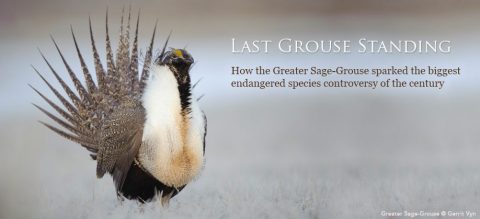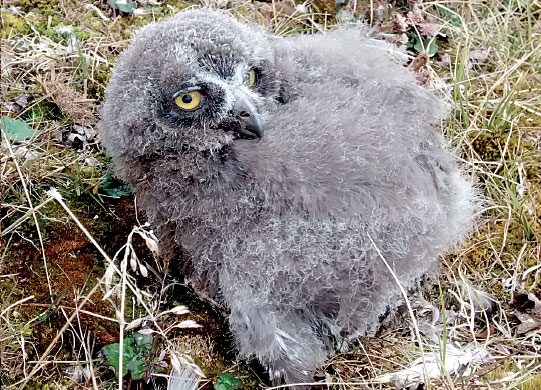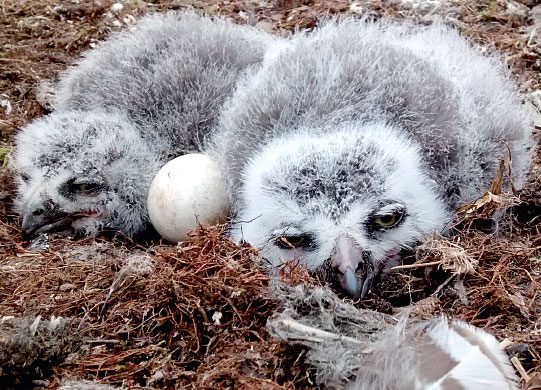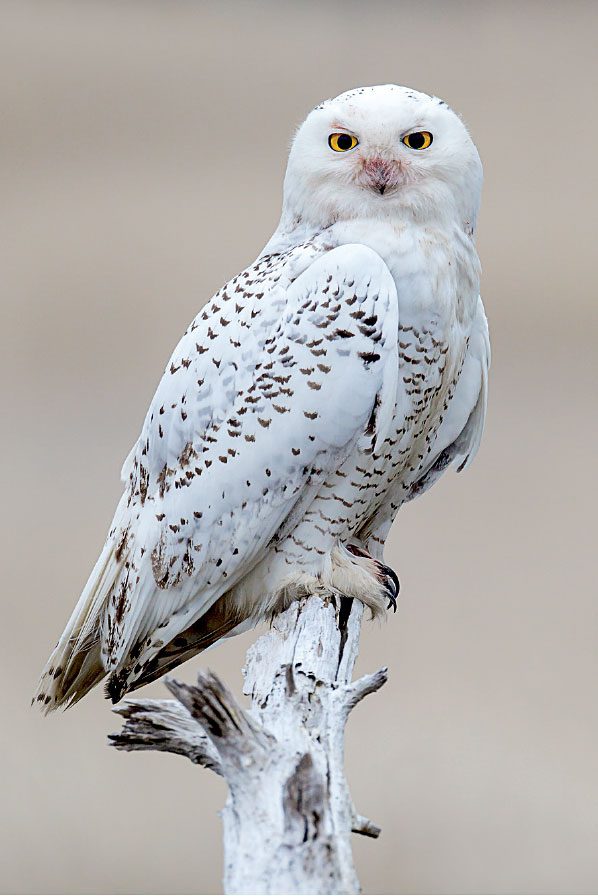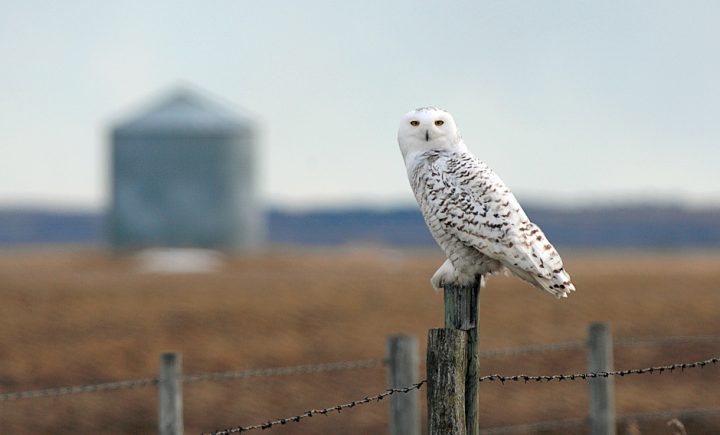At Home on the Alaskan Tundra With Snowy Owl Researcher Denver Holt
By Pat Leonard
From the Spring 2015 issue of Living Bird magazine.
An adult Snowy Owl flies to its nest with a lemming in its bill. The birds are so dependent on these small rodents that they may not breed in years when the lemming population is low. Photo by Dan Cox April 15, 2015The huge Snowy Owl irruption in North America during the winter of 2013–14 generated headlines around the world and made even non-bird watchers sit up and take note. The “echo flight” the next winter again brought this head-turning Arctic species farther south in higher numbers than usual. But there’s much more to the owls’ story than the occasional dazzling out-of-range cameo. You find it by heading north—way, way north. Snowy Owls spend most of their nomadic lives in the vast, frozen Arctic. They are a marvel of adaptation and perseverance. The same could be said for those who study them.
For the past 23 years, field researcher Denver Holt has traded summer warmth in the Lower 48 for the cold, windy tundra around Barrow, Alaska, 330 miles above the Arctic Circle. This is where Snowy Owls can consistently be found. A mild summer day here may top out in the mid-40s Fahrenheit, turning tundra grasses into a soft green-and-brown carpet but also launching hordes of bloodsucking mosquitoes. Temperatures in the mid-30s undercut by wind chill are just as likely. Layers of clothing and thigh-high waders are Holt’s business attire, and the company car is an ATV. Despite the challenges, Holt is committed to gathering data on the owls that inhabit his 100-square-mile study area.
“If my data are going to stand the test of time, then I have to get good on-the-ground data,” says Holt, founder and president of the Owl Research Institute in Montana. “If you’re going to study Snowy Owls you can’t do it in just one, four, five, six years. The important thing is long-term monitoring. That’s the kind of data that’s going to be more credible. If I studied Snowy Owls and lemmings for five years what would I be able to say? Not much, honestly, because both populations vary so much from year to year. All we can say for sure is that when lemming numbers are high, Snowy Owl numbers, nests, clutch sizes, hatching success, and fledging rates also increase on the breeding grounds in Barrow, and other species have a good year, too.”
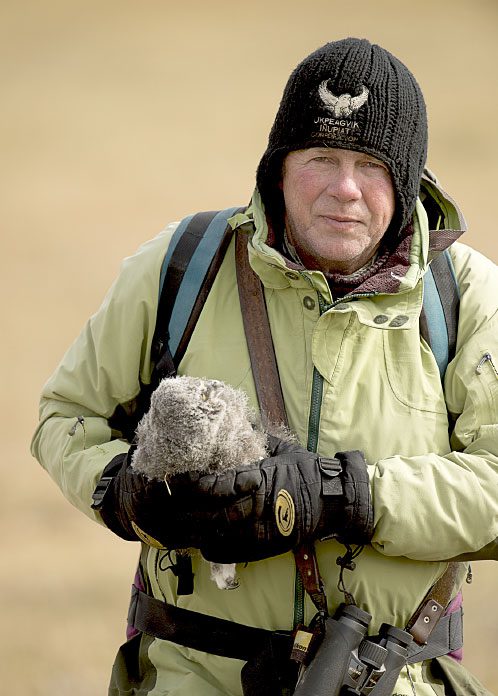
The Snowy Owl story, at its core, remains a mystery. Why does this powerful raptor breed only if lemmings are abundant—brown lemmings in the case of the Barrow birds? In years when lemmings are scarce, few or none of the birds breed, and many may not show up at all on the previous year’s breeding grounds.
“The whole lemming thing, to me, is really puzzling,” admits Holt, who has also been monitoring lemming populations in Barrow for 23 years. “I started out believing in lemming population cycles. I don’t believe that anymore. We know lemmings spend most of their time under the snow and that’s also when they breed. But we don’t know what factors combine to produce a boom or a bust in lemmings during the following spring and summer. And that’s key because lemmings drive the system. Ninety percent of a Snowy Owl’s diet in any year is lemmings and many other tundra animals eat lemmings, too, such as Arctic fox, weasels, jaegers, gulls, and cranes.”
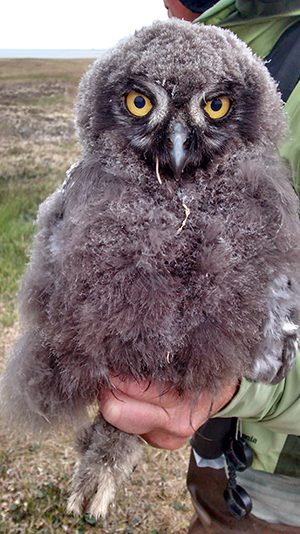
The summer of 2014 started well for the owls. Males courted females during late April and early May, doing a shuffle-dance to show off their wings and making courtship flights clutching dead lemmings, presumably to demonstrate their hunting prowess. Holt notes that only the glowing, bright white males get to breed. Because it takes several years for pure white plumage to develop, nonbreeding young males in Holt’s study area hang out in bachelor groups. The larger, more heavily barred females choose the nest site on a male’s territory, usually a snow-free mound about a meter high.
After arriving in Barrow in June, Holt located and began monitoring 20 nests. The 2014 breeding pairs all produced eggs and most of them hatched. Given that clutch sizes were relatively high, averaging about six eggs per nest, lemmings would have been abundant and “available” during the egg-laying period around mid-May. Then in late June to early July, chicks began disappearing. The owl family featured on a live nest camera hosted by the Owl Research Institute with explore.org and streamed on the Cornell Lab’s Bird Cams website is indicative of what was happening at nests all across the tundra near Barrow.
The cam nest was #2014-02. Seven eggs were laid. Seven hatched. Because eggs are laid about every other day (and incubation begins immediately), they hatch that way too. When the last chick hatched in late June, its oldest sibling was 11 days old. At about three weeks old, chicks start wandering away from the nest, though they are still unable to fly. They resemble little puffs of smoke with eyes and feet scooting about the tundra, still being fed by their parents.

This undersized chick is about 25 days old and was the only survivor from a clutch of seven eggs. Photo by Pat Leonard. 
A shortage of lemmings might be responsible for the low productivity of the nest. Nest #17 holds two chicks about 14 days old and one unhatched egg. Photo by Pat Leonard.
On July 3, the youngest cam chicks, six and seven in order of hatching, disappeared. Chick five went missing on July 6. Then the fourth chick was gone and the remains of the third chick were found. Only two of the original seven were still alive during a check on July 22 when they were 34 and 36 days old. The survivors were chicks 787 and 788, those being the last three digits on the leg bands Holt attached earlier in the season, as soon as they were old enough to wear them. Holt found 788 during this nest visit, and the other chick was seen scurrying away by sharp-eyed Bird Cam viewers. That’s good news—which got even better when the adult female fed 788 a lemming. Both these chicks made it to the fledging stage. (The average number of fledged birds for the season was about two per nest.) Finding out if they survive their first year will be a matter of luck, depending on whether or not they return to Barrow and are recaptured so their leg bands can be read.
Some chicks die every year, but last summer’s mortality rate around Barrow at nests that hatched chicks ranged from 40 to 100 percent. Holt says most of the chicks probably died of starvation. Again, lemmings are central to the story.
“There are very few lemmings in nests,” says Holt. “I visit every three days or so, and recently I haven’t recorded more than two lemmings per nest. At most nests I haven’t seen any. The lemmings I do find have less body mass than in high lemming years. I’m finding more birds and feather remains, so the owls are eating more birds.” In high lemming years, Holt and his assistants usually record 5 to 10 lemmings per visit, many times 15 to 20, sometimes even 30 to 40. A few times they’ve found nests with 50 to 70 lemmings piled around them. The highest number ever counted in the Barrow study area: 72 lemmings at one nest!
In a good lemming year there’s so much food, even the smallest chicks get some and the odds of survival are better. This was not one of those years. Somewhere along the way the number of lemmings during the summer of 2014 either flattened out or declined for unknown reasons. In the unsentimental arithmetic of nature, the youngest chicks usually die first, outcompeted by their older, larger siblings for parental food deliveries. In dire straits, the adult female’s instincts trigger another grim strategy as she feeds the dead chicks to the others. As a mother, she is doing whatever she can to help her remaining offspring survive, and this is desperately needed protein.
The true measure of success for any breeding season is whether the offspring survive to reproduce in the future. That’s particularly difficult to determine with Snowy Owls because Holt can only follow them through fledging. Even though he’s banded about 700 chicks and some adults over the years, not many return to be sighted again in Barrow in the following years. He’s spotted a few, but to identify an individual he must capture the bird again to read its leg band. Holt says the adults are extremely difficult to catch, especially the males. The Snowy Owl’s penchant for unpredictable movements over the vast, inhospitable Arctic is yet another obstacle. Holt’s early satellite-tracking studies found tagged owls traveling from Barrow to Russia to Canada—and then back to Alaska again over a period of years. Holt is now trying to use feather DNA to identify individuals and look into nest-site fidelity, mate fidelity, survival rates, and, importantly, to determine whether the owls’ itinerant lifestyle is driven by the search for areas where lemmings are abundant.
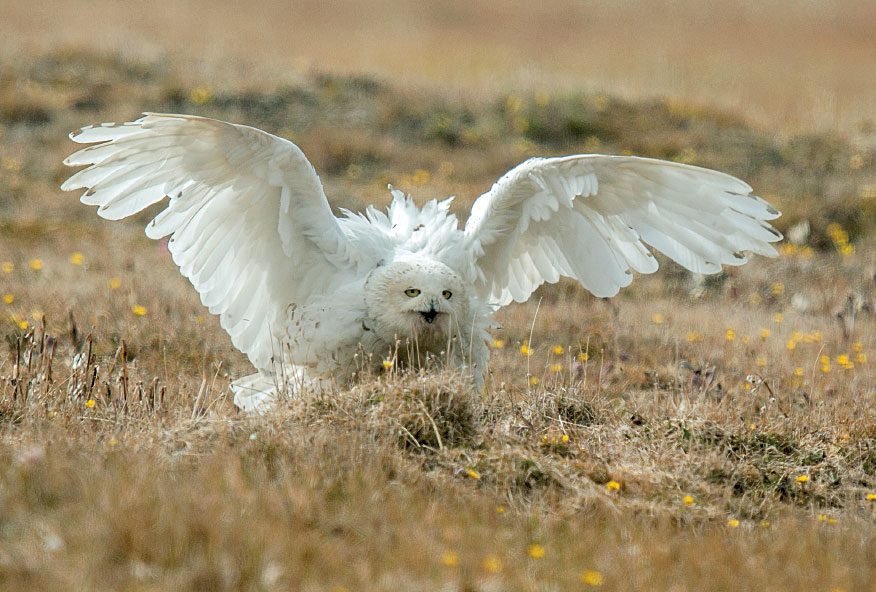
Based on his studies, Holt says the overall population trend for Snowy Owls and lemmings in the Barrow area is down. What’s happening to Snowy Owl populations worldwide is still a matter of debate. Some estimates place the global population at 300,000 to 400,000. But a 2014 statement from the International Snowy Owl Working Group (of which Holt is a member) revised its estimate downward to 28,000 individuals.
“Nobody knows the answer,” Holt states. “We have very little quantitative data. We would have to somehow figure out how to do a simultaneous survey throughout the entire Arctic to come up with a believable number. But there’s no way we’re going to be able to do that so we’re just going to guess, and to pretend these are really good guesses—but the bottom line is, they’re guesses.”
Holt is not the only one looking for answers in Barrow. The town is packed with scientists probing the multifaceted juggernaut that is climate change. There are ice specialists, marine mammal and fish specialists, experts on the permafrost and methane and CO2 emissions, along with others who study plants, polar bears, seals, and shorebirds. Climate change is already a fact in the Arctic. According to NOAA’s Arctic Action Plan, issued in April 2014, “One dramatic change is the loss of sea ice covering the Arctic Ocean and its peripheral seas.…Since the 1980s, 75% of Arctic sea ice volume has been lost.…This rapid loss of sea ice is affecting weather patterns, marine and terrestrial ecosystems, and human activities.” For Holt, the next step is figuring out where the owls and the lemmings fit in and if they are being affected by these far-reaching changes.
For most of us who are involved in long-term research,” Holt explains, “we didn’t start out studying our animal’s relationship to climate change. We studied our animals. Now we’ve got to bring in a climate-change specialist to see how we can weave it all together. The data we’ve gathered over the years is so big now that I really need to find a house in Baja with no phone and no email to work on it, and I need to have enough money to hire a statistician who knows biology.”
Even after 23 years, Holt still has plenty of other questions to pursue when it comes to the Snowy Owl—questions about the bird’s mating system, nest defense behavior, sexual selection, growth rates, plumage development, and the unbreakable relationship between the owls and lemmings.
Holt wants to tap into the human relationship with owls to give some oomph to conservation. He views the Snowy Owl as the perfect ambassador for Artic conservation. Lemmings are just as important, but the pragmatic Holt feels that using a rodent as the poster child for Arctic conservation would be a tough sell.
“I’ve been pitching for years that in all habitats we can use owls as indicators of the health of the ecosystem and as generators of public support and goodwill,” says Holt. “There’s just something about owls. They look right at you. They are perhaps the most recognized group of animals in the world and one of the most admired. Their human-like faces are probably one of the reasons we admire and relate to them.”
You can count Holt among the admirers. Snowy Owls have kept him guessing for a long time now, and he’s not done yet. “I don’t know how long I can do this,” he says. “I can still climb trees better than all the students—I can’t outrun them anymore but I can still climb better. My stamina is still really good, and I’m still plenty strong. Ideally, I would like to get 10 more years of data from Barrow, but if I get 30 years, and I’m at 23 now, I’d be okay with that.”
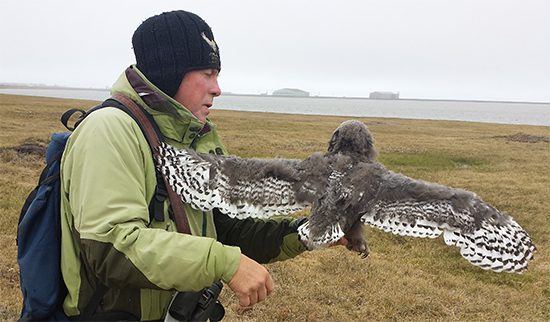
Holt’s attachment goes beyond scientific inquiry—with the Snowy Owls, it’s personal. “I really like them,” he says. “They’re just cool animals. But they don’t like you at all. They never get used to you. They don’t say ‘Here comes Denver, and here comes the owl crew, don’t worry, everything is going to be fine, they’re not going to hurt us.’ They do the same behavior every time you show up—some hoot, some bark at you, and others just attack. They’re magnificent!”
With a few more cold summers with the owls in Barrow under his belt, Holt feels he will have enough data to draw some solid conclusions about Snowy Owl breeding behavior and lemming biology. “Then I will have a good story to tell,” he says. “Right now I have a pretty good story to tell but it’ll be a better story, especially with what’s going on with changing climate.” Stay tuned.
Learn more about the Owl Research Institute at owlinstitute.org. Watch a video about Holt’s Snowy Owl field work near Barrow during the summer of 2014 at http://tinyurl.com/ookjnzm.

All About Birds
is a free resource
Available for everyone,
funded by donors like you
American Kestrel by Blair Dudeck / Macaulay Library
